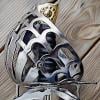Looking for a tutorial for magnet-deformer sets to autofit clothes.
I'm looking to reduce the poke through on a dress I have for my custom V4 character. Since she's muscular and has a wider chest, she always pokes through any clothes. Even clothes that have custom morph fixer dials for chest, waist, thighs etc still don't always work for this character. After looking around I found this guide ( http://elton-atlantis.blogspot.com/2009/02/how-to-use-magnet-fits-in-daz-studio.html ) that says I can apply magnets to clothes to make my own auto fit of sorts.
Since my character is custom dialed do I need to make my own morph magnet set? How would I do that?



Comments
I am, by no means, an expert at this, but since you haven't gotten a response yet, I figured I'd try to give you a hand. What you are wanting to do, to create a custom "magnet" in DAZ Studio is create what is called a "D-Former" (You can also try the option to right click your selected piece of clothing, and select "Fit to..." and select your figure in the pop-up. DAZ Studio's "Auto-fit" is extremely powerful, and can really be quite handy in many situations, especially when using the Genesis figure. Anyway, to create your own D-forms, select the item you are wanting to D-Form.
Then, (this is the way I do it) go up to CREATE on the main menu bar (up at the very top) and select New D-form. This spawns 3 pieces in your viewport. The first piece is a sphere that looks like a series of rings interconnected. This is your DForm field. The size and position of this sphere controls where and how much of the model is deformed by the other two controls. Within the sphere you should see (if it is working correctly) a bunch of red and yellow dots (vertices) on the model you are creating a DForm for. These dots are showing the vertices that are to be manipulated by the DForm, in varying colors based on influence of the DForm and its fall off. Red being of the greatest influence to invisible, which is "no influence".
The second part of the deform is a plate (which has a cylindrical arrow next to it) that serves as the base for your deform. You place this (via rotate and translate tools) where and what angle the DForm should be taking place (at least, that's how I do it) along the surface of the model you are changing. Which leads to the 3rd part of a DForm, which is that cylindrical arrow.
By moving this arrow away from the "plate" that it spawned with, you control the strength of the deformation, as dictated by the DForm field and the Plate Base. If this doesn't make sense to you, check out this YouTube video on DForms: http://www.youtube.com/watch?v=7SEBV2GHJHA
Good luck!
If you are using DS4 or DS4.5 it might be easier to use smoothing/collision.